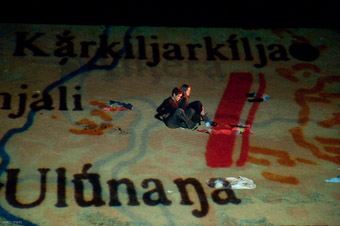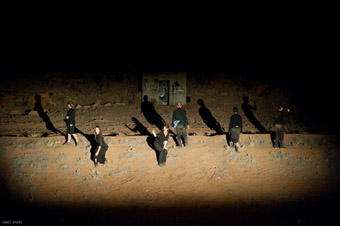the art of excavation
jennifer mills: red shoes’ under today

Under Today, red shoes
photo James Spiers
Under Today, red shoes
IF YOU DIG INTO THE SOIL OF ALICE SPRINGS’ EASTSIDE SUBURB, YOU WILL FIND A LAYER OF SHALE PUT THERE BY US TROOPS DURING WORLD WAR TWO TO KEEP THE DUST DOWN. “OCCASIONALLY YOU’LL FIND A PENNY”, ACCORDING TO ONE OF THE LOCALS IN AN ORAL HISTORY RECORDING EMBEDDED IN RED SHOES’ NEW PRODUCTION, UNDER TODAY. IN WW2 THE TOWN BECAME NO 9 AUSTRALIAN STAGING CAMP FOR THE US MILITARY, AND MANY LOCALS WERE EVACUATED SOUTH. IT’S JUST ONE OF THE BURIED SEAMS THAT THIS PRODUCTION SEEKS TO UNCOVER.
The performance—part dance, part multimedia projection—is staged in a drain, a redirected creek that runs between the houses of Eastside and the rocky bulge of Spencer Hill. Patrons are seated along one bank and the work centres on the other, but extends back to take in the hill, two ghost gums, a graffitied storage shed left over from WW2 and a large section of the creek.
At dusk, a low drone sounds from the speakers and figures in black begin to descend from the hills. They are anonymous silhouettes, camouflaged in the landscape. The fading light is used to full effect. Incorporating the natural and built environment has clearly been a priority for director Dani Powell who seeks with this work to “see place as a series of layered stories.”

Under Today, red shoes
photo James Spiers
Under Today, red shoes
Alice Springs (Mparntwe) has a 300-generation history with little built intervention on the landscape. Since the establishment of the Telegraph Station in 1872, however, it has gone through several periods of rapid development: growth spurts and demographic shifts because of gold, war, work, migration and the ongoing process of colonisation. It is refreshing that these shifts are treated here without too much finger-pointing or moralising, just presented as facts underlying our everyday experiences of place. The temptation to sentimentalise ‘the old days’ is largely avoided.
There are some bright pennies to be found in Under Today. At the core of the piece are recorded oral histories, many of which were collected specifically for this work. Listening to these is a pure pleasure, and fascinating as this small corner of the world is described in its previous incarnations. The old trees take part in the show and, among the rewards of the site-specific staging, a bat dances a circle around a performer during a solo.
The staging is a highlight. Light and shadow are exploited to full effect as dancers turn old clothes into shadow puppet theatres, their bodies into frames and later become shadow puppets themselves. The rags on the set become ghostly bodies and are finally burned in a reminder of the role of fire in the landscape and perhaps a nod to the real campfires that sparkle down the river as we watch. The innovative use of this otherwise neglected space is delightful.
At times, the extent of the space and an episodic structure make the movement work inaccessible and it can be difficult to understand what the dancers are communicating. The anonymous figures’ reluctance to directly address the audience detracts from the personal nature of the oral histories. This obscurity is in part a problem of interpretation from a distance: the dancers are perhaps dwarfed by the scale of the projections. Under Today might be more effective on a smaller scale, with more robust choreographic intention.
The production also assumes a sombre mood which doesn’t seem entirely warranted. Is history always so serious? Under Today comes alive in moments when it drops this tone and relaxes into the story, embracing humour, such as when six solo waltzers come down the hill as an old Italian pizza shop owner talks about the history of his business.
Projected maps play across the ground, telling us the Arrernte names for the places we see, many of which have been developed and renamed without permission from the traditional owners. The right language for this country is embedded in Under Today with gentle assurance. Later another map of the suburb’s lots scrolls up the creek bed as the figures enact a town-planner dance of finger pointing and line drawing, a parody of bureaucratic discipline which garners more chuckles.
At its best, Under Today is a wonderful exploration of the depth of experience hidden in a specific place. Given that this is a developmental showing, Under Today is a promising work with a gently archaeological intention which has the potential to reach a much broader audience.
red shoes, Under Today, producer, animateur, director Dani Powell, media artist Alexandra Gillespie, sound artist Guy Webster, dancer/choreographer Miriam Bond, performer/maker Frances Martin, dancer/choreographer Mariaa Randall, performers Kristy Schubert, Matty Day, Fina Po, Rita-Mae Ross, lighting designer Kallum Wilkinson, consultants senior Arrernte women Kumalie Riley, Veronica Dobson, anthropologist Mike Cawthorn; Gosse St Park, Eastside, Alice Springs, Oct 17
RealTime issue #94 Dec-Jan 2009 pg. 40






